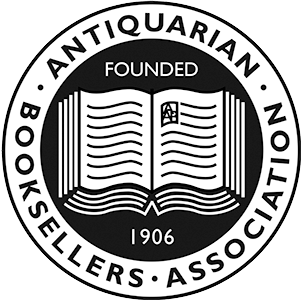London: Pub.…by N. Heideloff, 1794. The First Two Volumes of “the Most Splendid of English Costume Books”
"A Very Difficult Book to Find in Good Condition"
The Copy of Maria Christina, Queen of Spain
[HEIDELOFF, Nikolaus Wilhelm von, publisher]. Gallery of Fashion. Vol. I, April 1794-March 1796. [London]: Pub.…by N. Heideloff, 1794-1796.
First edition of volumes 1 & 2. Quarto (11 1/8 x 8 3/4 inches; 284 x 222 mm.). [2] Advertisement, [48], [3] List of Subscribers, [1] blank; [2] Advertisement, [48], [2] List of Subscribers. Two hand-colored engraved title-pages and forty-nine hand-colored aquatint plates depicting ninety figures of fashionably dressed ladies. Each plate with descriptive text.
Spectacularly bound c. 1835 in red straight-grain morocco, unsigned, yet to all appearances the work of the firm of Charles Hering, "the artistic successor to Roger Payne, the doyen of English bookbinders" (Marks). With a broad and boldly gilt tooled frame with corner devices enclosing a gilt panel featuring large gilt pointillé cornerpieces, an intermediate gilt ornamented frame sandwiched in between, to both covers. Elegantly gilt decorated compartments. Extra-wide gilt tooled and rolled turn-ins with gilt fillet and Greek key borders framing gilt rolled and ornamented pale blue moiré silk pastedown endpapers. Gilt rolled and ornamented pale blue moiré silk free-endpapers. All edges gilt. Attribution to the Hering bindery based upon close comparison with the Hering bindings found in Maggs' Bookbinding in the British Isles and Marks' Bookbinding Practices of the Hering Family 1794-1844. With the royal armorial bookplate of Maria Christina Reina de Espana (1806-1878), wife of Ferdinand VII.
Only 167 copies were subscribed to for this first volume in 1794, including “the Princess Royal, the Princess Augusta, the Princess Elizabeth, the Duke of York and the Empress of Germany” (Holland, p. 48). Complete sets in fine condition, when found, have sold for upwards of $100,000.
“The most splendid of English costume books, and the first real venture in this country of a periodical devoted to the changing taste in dress…Volume IX is notoriously rare… No artist’s or engraver’s names are given, but the plates are probably the work of the publisher, Nikolaus Wilhelm von Heideloff (1761-1839). After April 1802 (Volume IX), the name of Heideloff ceases to appear in the imprint. Many plates also after that month are undated, and the magazine seems to have passed into other, and less competent, hands” (Abbey, Life).
“After the Gallerie des Modes came to an end in 1787, there was a gap in the production of really fine costume-plates until 1794, when Nicolaus Wilhelm von Heideloff appears on the scene. Heideloff was born in Stuttgart in 1761, and was brought up to be an engraver. In the 1780s he migrated to Paris, where he lived by painting miniatures until the outbreak of the French Revolution dispersed his clientèle. We next hear of him in London, where he obtained employment with R. Ackermann…This connection is significant in view of Ackermann’s subsequent interest in fashion-plates; it is not known how long it lasted, but in April 1794, when Heideloff was thirty-three years of age, he struck out on his own and started issuing The Gallery of Fashion. The Gallery of Fashion was nearer to the true fashion-plate than anything of its ambitious nature that had preceded it, though it was still meant to be more a record of existing modes than designs for the future. Indeed, in an advertisement announcing his forthcoming publication, Heideloff says that the dresses ‘are not imaginary but really existing ones’, and he goes on to say that they are intended to be ‘a Repository of English National Dresses of Ladies’. This publication was issued in monthly parts, each part consisting of two aquatints, beautifully coloured by hand and enriched with gold, silver and other metallic tints. The yearly subscription was three guineas, and it lasted until March 1803, when it had completed exactly nine years of existence. Thus, with twenty-four plates issued each year (except in the second year, when the number was twenty-five), the total number of plates issued by Heideloff was 217. In addition to this, each yearly volume was supplied with a beautiful allegorical title-page, also in hand-coloured aquatint. And, of course, each plate was accompanied by a detailed description of the dresses which it depicted. Each plate showed either one, two or three figures, the total number shown being 362. The groups of figures in The Gallery of Fashion are shown in a large number of different occupations, such as out driving in a berlin, playing and singing at the harpsichord or the harp, taking tea and strolling at the seaside with their children. They are provided with accessories, such as muffs, fans, telescopes, bonnets, books and parasols, to say nothing of dogs, watches, tippets, gloves and a vast variety of trinkets. The majority of the plates represent outdoor scenes. We can arrive at a fairly accurate estimate of the circulation of The Gallery of Fashion, as in many of the volumes are given lists of subscribers…So we find that the total number of copies subscribed for was 347 in Great Britain and sixty-seven abroad. It is therefore reasonable to say that the total issue was never more than 450 at any time of its career; the number of separate copies sold (at seven shillings and sixpence an issue) must have been very small…The Gallery of Fashion…is a very difficult book to find in good condition and complete in every respect” (Vyvyan Holland, Hand Coloured Fashion Plates 1770 to 1899, pp. 46-48).
Charles Hering was a master bookbinder and native of Germany who settled in London and "by 1794 had his own business... He soon became one of the principal West End binders with three finishers, six forwarders, and two apprentices. He worked for many of the great libraries of the day, including Lord Spencer's [George John Spencer, 2nd Earl Spencer, ancestor of Princess Diana] and Thomas Grenville's. Dibdin states that 'till the star of Charles Lewis rose above the bibliopegistic horizon, no one could presume to measure business with him. There was a strength, squareness, and a good style of work about his volumes which rendered him deservedly a good favourite'" (Marks, Bookbinding Practices of the Hering Family 1794-1844). Hering's sons took over the firm at their father's death and continued managing the firm until it was bought in 1845.
Abbey, Life, 218. Colas 1170. Hiler, p. 351. Lipperheide 4578. Tooley 258.
















